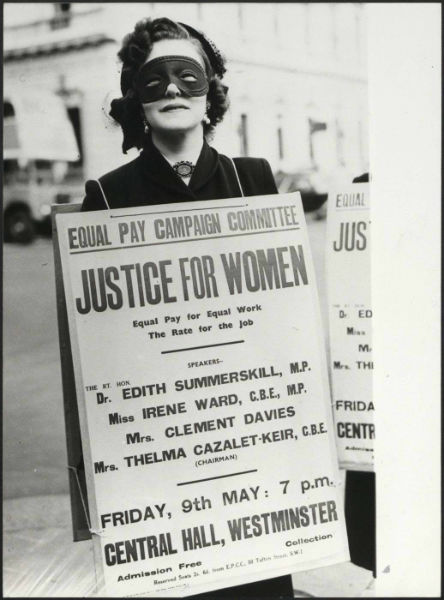Guy Fawkes the Feminist

Photograph taken at the 'Equal Pay for Women' campaign in London, 1952. Image © The People's History Museum. Further reproduction prohibited without permission.
Excuse me - late to the party, as always - but last week, International Women’s Day, the annual celebration dedicated to championing 50% of the population for 0.27% of the year, rolled around once again.
British MP, Jess Phillips, stood in Parliament for six minutes to read out the names of every woman murdered by men in the past year; Emma Watson – who has abandoned house elf rights for women’s rights – made headlines by brushing off the slur “feminazi”; and political satirist, John Oliver, shone a light on a Fox News pundit who used the day to thank American men for being kinder to women than the Taliban.
Organised in New York in 1909, the first National Women’s Day was a commemorative event for a strike held by the International Ladies’ Garment Workers’ Union a year earlier. In the West, rights for women have improved immeasurably since those days, but feminist issues continue to hit the headlines. Mere hours ago, Michelle Obama launched a high-profile education programme for young girls around the world. On Wednesday, Canadian Prime Minister, Justin Trudeau, spoke to the UN and lamented that in 2016, declarations of feminism still cause the Twitterverse to ‘explode’. Last year, Oscar winner, Patricia Arquette, with the eyes of Hollywood’s elite upon her, slammed the industry for sexism and called attention to the inconsistency of pay not just in the sequined upper echelons, but lower down the socio-economic ladder too. Suffragette, tracing the early days of the women’s movement, was released months later and reaped $16 million worldwide. This year, nothing – seemingly - stands between Hillary Clinton and a historic return to the White House apart from one reputedly short-fingered billionaire.
So many historical documents are concerned with governance and economics; such top down histories inevitably tend towards the male, pale and stale narrative. When I went rooting through our resources to find some female perspectives, I was grabbed by these images from our resource Popular Culture in Britain and America, 1950-1975.

From 'Photographs, Women's Rights and Equality', 1952. Image © The People's History Museum. Further reproduction prohibited without permission.
The first shows two women, poker faces in place, stood outside the residence of the Chancellor of the Exchequer in October 1952. In another from the same collection, equal pay is put on trial in a mock court. Photographs taken during the ‘Equal pay for Women’ campaign, meanwhile, showcase protestors lifting signs daubed with slogans such as ‘overworked and underpaid’ while marching through London.
Published between 1968 and 1980, photographs from the Mirrorpix archive bear witness to scenes of women demanding access to abortions, contraception and child care. In one, a mini-skirt wearing protestor demands ‘Equal Pay Now’, while in the background a slogan points out that Barbara – presumably Castle, Labour MP and sometime Secretary of State for Employment – already has it. Elsewhere, women grin at the camera while chained to the railings at Parliament. 
Two images taken from 'Women's Liberation', c. 1968-1980. Image © Mirrorpix. Further reproduction prohibited without permission.
My favourite photograph features three protestors standing in front of Big Ben in the dark; while one placard reads, ‘We want more women!’, the other takes a revisionist view of seventeenth century history, claiming that ‘Guy Fawkes wanted fewer men in Parliament’. Well, yeah, I suppose he did.

Guy Fawkes wanted fewer men in Parliament, c. 1968-1980. Image © Mirrorpix. Further reproduction prohibited without permission.
Finally, I stumbled across a pamphlet dedicated to International Women’s Day. One image in particular caught my eye; an invitation to celebrate the 1972 event. Across the decades, two women clasp hands – one a high-collared suffragette demanding voting rights, an eight hour day and the abolition of child labour, and the other a polo-neck clad campaigner for child care and equal pay. This document is illustrative of how - from the right to vote to equal pay - the feminist movement has evolved over time, and how it continues to do so, edging slowly closer towards equality around the globe.

Taken from 'International Women's Day 1970-77'. Image © University of California, Berkeley. Further reproduction prohibited without permission.
Popular Culture in Britain and America, 1950-1975: Rock and Roll, Counterculture, Peace and Protest is available now. Full access restricted to authenticated academic institutions who have purchased a license.
Recent posts

Step into the vibrant tapestry of the 1980s, where anti-nuclear protests, political upheavals, and iconic figures like Margaret Thatcher and Ronald Reagan mingled with the neon glow of shoulder pads, arcade games, and synthesizers. Amy Hubbard, editor explores materials from AM's 1980s Culture and Society, a rich exploration of this era's excesses, innovations, and contradictions, covering topics from Conservatism's rise to the explosion of electronic music. Discover how technology transformed not just leisure but also communication, creativity, and societal landscapes, leaving an indelible mark on the decade's cultural fabric.

Amnesty International Archives features hundreds of thousands of images, including every Urgent Action issued between 1974-1991 detailing requests for action to intercede in humanitarian crises and protest atrocities around the world. The campaigns, internal developments and press perceptions of Amnesty are all explored in detail through the documents that are featured in the resource.
